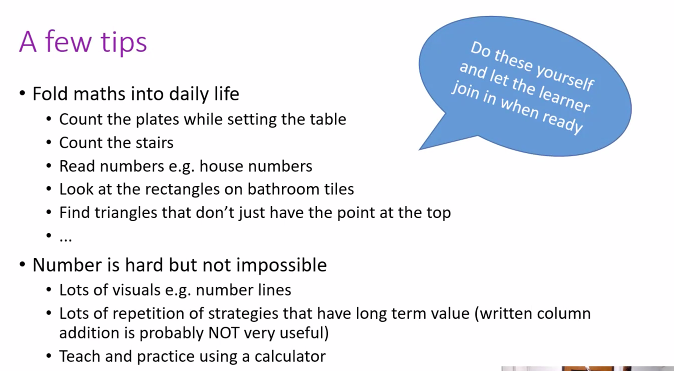Numeracy & adapting the curriculum with Dr Rhonda Faragher
Teach the student the same math that is being taught in their level with adaptations or adjustments. Year level adjusted curriculum is about allowing kids to move past holes and perhaps fill them as they go.
Our understanding of quantity gets pegged to the word (or the language). For children with down syndrome, we need to focus on the symbols. Visuals, such as number lines are essential.
Problems with number may be a deficit in number processing. However, other areas of mathematics are accessible.
Use calculators! Talking calculator as an app on the iPad can work wonders.
Don't forget the other areas of maths! Geometry, statistics, algebra, etc.
Don't Test!
Low expectations have held learners back!
Numeracy in Practice – Numicon with Catherine Huxford
Why use numicon?
Maths is a subject about abstract ideas. People with Downs Syndrome find abstract concepts very difficult to grasp. Numicon works to the strengths of the learners, as they learn through visual.
Teaching is modelling something, not asking children to show what they know. That is testing!
Using numicon, you can order them from smallest to biggest. You can identify the staircase and that numbers are getting bigger. Adding one more, I'm making the shape of one more (right next door). It is visual for children to see which is bigger.
Great for identifying odd numbers with the sticky one bit. (LOL)
Addition, simply add the two bricks together. Find the block that is the same shape. Do not teach addition unless the children know that number names of the numicon shapes.
Bonds to ten with the rainbow movement of the shapes. You can notice patterns here with stairs happening on both sides.
Can look at place value too:
Another way of showing place value could be side by side. This will show the tens and the ones
We can look at fractions and decimals too! Consider the ten block to be one whole. So the one can become one tenth.
Using a base board, we can teach fractions and percentages too. The image below can show 57%.
Can show fractions. Show the connections between 1/6 and 2/12 (have two of these below)
Show the patterns between numicon and ten frames
Numicon isn't just shapes. It is an approach to teaching maths.

Literacy and how to use the curriculum with Dr Sally Clendon
Use key words with common rimes. So for example when teaching ick words, they can associate it with a keyword like pick. From here, they will learn that they can also spell sick, lick, stick, etc.
Within writing, we need to look at form and function. Here Rick is showing he has function and will move faster along with his learning in writing, compared to Brian, who hasn't learnt that he is writing his name.
Writing could be scribble! We need to see how they are progressing themselves, rather than using copying or tracing. It is critical that we don't skip over the need for them to understand they are conveying meaning through making marks on paper.
Do not push any cognitive strain on students before they are motivated to write on their own, for example, don't worry so much about form or punctuation etc.
Handwriting and writing should be taught separately. We do not want students to learn that handwriting is writing or that copying is writing.
Using visuals to assist in accessing the curriculum with Fiona Kenworthy
Use visuals. We can create a student profile which they can share with others. Use visuals to show, because it is easier for them to understand and to share.
Collaboration for Success – IEPs with Andrea Smart


















No comments:
Post a Comment